
The following thesis penned by U.S. based David Roberts was published on https://www.vox.com/ dated October 21, 2020. He covers climate change, clean energy and the politics of both at Vox.com and his work has featured in The Chicago Tribune, Reuters and The Atlantic. He has also made appearances on CNN and the Canadian Broadcasting Corporation.
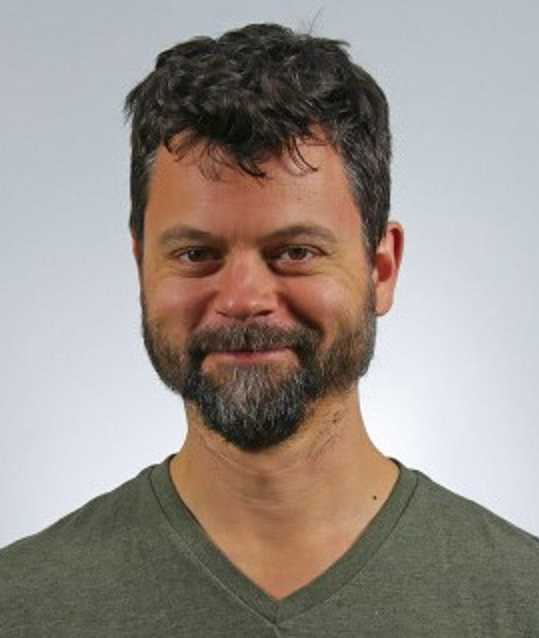
Geothermal energy is poised for a big breakout “An engineering problem that, when solved, solves energy.”
Geothermal power is the perpetual also-ran of renewable energy, chugging along in the background for decades, never quite breaking out of its little niche, forever causing energy experts to say, “Oh, yeah, geothermal ... what’s up with that?”
Well, after approximately 15 years of reporting on energy, I finally took the time to do a deep dive into geothermal and I am here to report: This is a great time to start paying attention!
After many years of failure to launch, new companies and technologies have brought geothermal out of its doldrums, to the point that it may finally be ready to scale up and become a major player in clean energy. In fact, if its more enthusiastic backers are correct, geothermal may hold the key to making 100 percent clean electricity available to everyone in the world. And as a bonus, it’s an opportunity for the struggling oil and gas industry to put its capital and skills to work on something that won’t degrade the planet.
Vik Rao, former chief technology officer at Halliburton, the oil field service giant, recently told the geothermal blog Heat Beat, “geothermal is no longer a niche play. It’s scalable, potentially in a highly material way. Scalability gets the attention of the [oil services] industry.”
In this post, I’m going to cover technologies meant to mine heat deep from the Earth, which can then be used as direct heat for communities, to generate electricity, or to do both through “cogeneration” of heat and electricity. (Note that ground-source heat pumps, which take advantage of steady shallow-earth temperatures to heat buildings or groups of buildings, are sometimes included among geothermal technologies, but I’m going to leave them aside for a separate post.)
Before we get to the technologies, though, let’s take a quick look at geothermal energy itself.
What is geothermal energy?
Fun fact: The molten core of the Earth, about 4,000 miles down, is roughly as hot as the surface of the sun, over 6,000°C, or 10,800°F. That’s why the geothermal energy industry is fond of calling it “the sun beneath our feet.” The heat is continuously replenished by the decay of naturally occurring radioactive elements, at a flow rate of roughly 30 terawatts, almost double all human energy consumption. That process is expected to continue for billions of years.
The ARPA-E project AltaRock Energy estimates that “just 0.1% of the heat content of Earth could supply humanity’s total energy needs for 2 million years.” There’s enough energy in the Earth’s crust, just a few miles down, to power all of human civilization for generations to come. All we have to do is tap into it. Tapping into it, though, turns out to be pretty tricky.
The easiest way to do so is to make direct use of the heat where it breaks the surface, in hot springs, geysers, and fumaroles (steam vents near volcanic activity). The warm water can be used for bathing or washing, and the heat for cooking. Using geothermal energy this way has been around since the earliest humans, going back at least to the Middle Paleolithic.
Slightly more sophisticated is tapping into naturally occurring reservoirs of geothermal heat close to the surface to heat buildings. In the 1890s, the city of Boise, Idaho, tapped one to create the US’s first district heating system, whereby one central source of heat feeds into multiple commercial and residential buildings. (Boise’s downtown still uses it.)
After that came digging deeper and using the heat to generate electricity. The first commercial geothermal power plant in the US was opened in 1960 in the Geysers, California; there are more than 60 operating in the US today.
The technology for accessing deep geothermal is developing at a dizzying pace these days. Let’s take a look at its basic forms, from established to experimental.
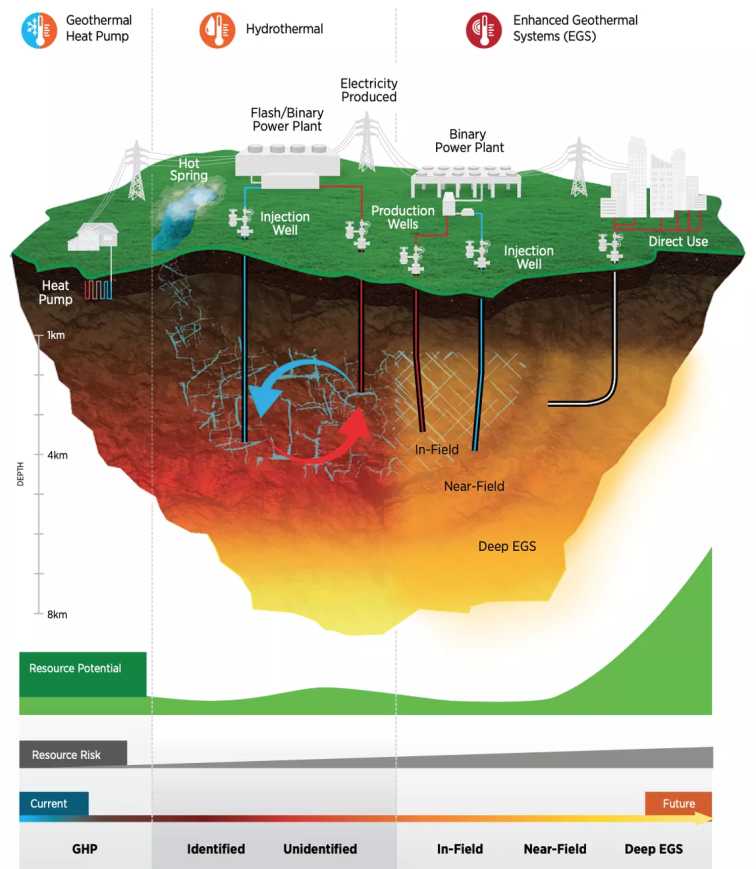
Four basic types of geothermal energy technology
Once it reaches the surface, geothermal energy is used for a wide variety of purposes, mainly because there are many different ways to use heat. Depending on how hot the resource is, it can be exploited by numerous industries. Virtually any level of heat can be used directly, to run fisheries or greenhouses, to dry cement, or (the really hot stuff) to make hydrogen.
To make electricity, higher minimum heats are required. The older generation of geothermal power plants used steam directly from the ground, or “flashed” fluids from the ground into steam, to run a turbine. (The water and air pollution that has been associated with first-generation geothermal projects was all from flash plants, which boil water from underground and end up off-gassing everything in it, including some nasty pollutants.)
Flash plants require heat of at least 200°C. The newer, “binary” plants run fluids from the ground past a heat exchanger and then use the heat to flash steam (meaning the underground water isn’t boiled directly and there’s no air or water pollution). Binary plants can generate electricity from around 100°C up.
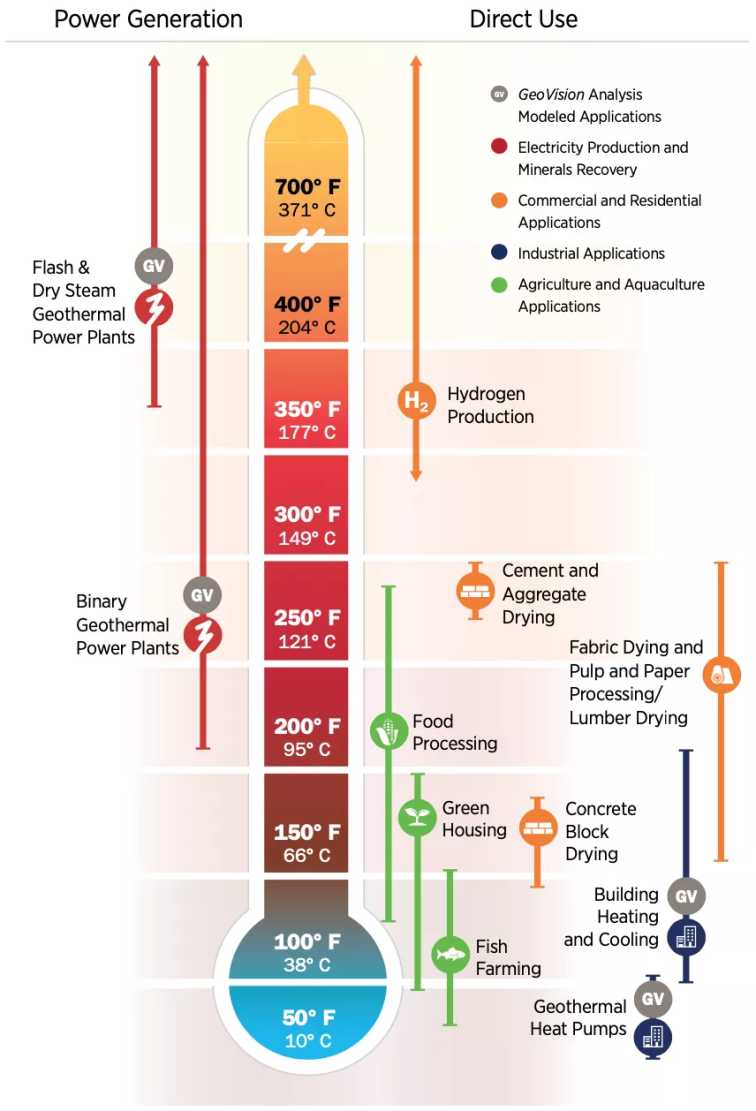
Getting the heat to the surface is the trick. For that purpose, it’s useful to think of geothermal energy technology as falling into four broad categories.
1) Conventional hydrothermal resources
In a few select areas (think parts of Iceland, or California), water or steam heated by Earth’s core rises through relatively permeable rock, full of fissures and fractures, only to become trapped under an impermeable caprock. These giant reservoirs of pressurized hot water often reveal themselves on the surface through fumaroles or hot springs.
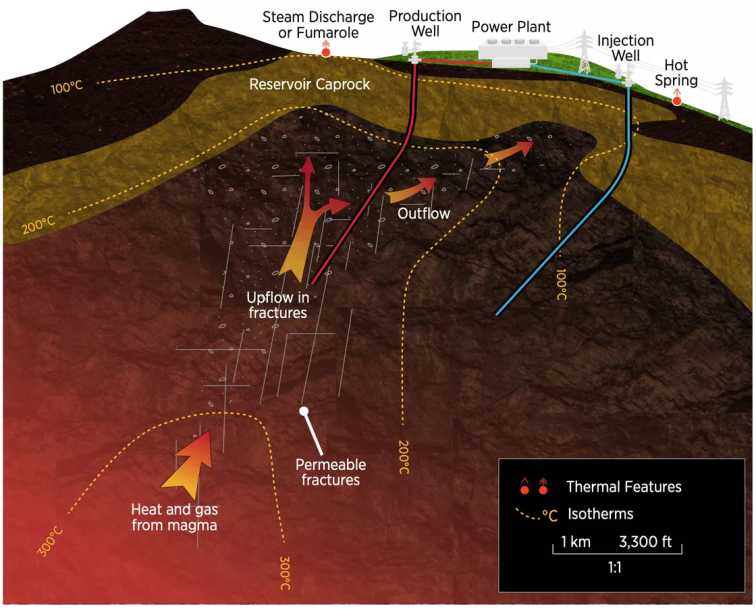
Once a reservoir is located, exploratory wells are drilled until a suitable location can be located for a production well. The hot water that rises through that well can range from just over ambient temperature to 370°C, depending on the field (to get into temperatures hotter than that requires going deeper; more on that later). Once heat is extracted from them, the fluids are cooled and returned to the field via an injection well, to maintain pressure.
Almost all conventional geothermal projects, most of what’s now running, make use of high-quality hydrothermal resources.
One problem with hydrothermal reservoirs is that their visible manifestations — hot springs and fumaroles — remain the only reliable way to identify them; exploration and characterization of new fields is expensive and uncertain. (This is one area of furious technological development.)
Another problem is that they are extremely geographically concentrated. In the US, geothermal electricity is mostly located in California, Nevada, Hawaii, and Alaska, where tectonic plates are grinding beneath the surface.
Where hydrothermal resources are readily available, the advantages of geothermal energy are well-understood. The global geothermal electricity fleet has an average capacity factor — time spent running relative to maximum capacity — of 74.5 percent, and newer plants often exceed 90 percent. Geothermal can provide always-on, baseload power; it is the only renewable resource to do so.
As of the end of 2019, global installed geothermal electric capacity, dispersed across 29 countries, reached 15.4 GW, with the US in the lead.
Top 10 Geothermal Countries Installed Capacity – MW (July 2019) – 14,900 MW in total.
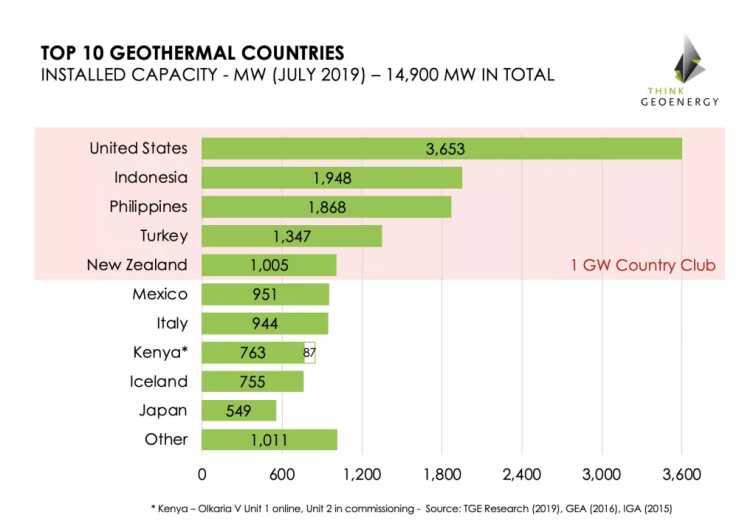
The final problem is that most of the big, well-explored, well-characterized fields have been tapped out, at least with conventional technology. Geothermal that relies on high-quality hydrothermal resources remains a niche solution, difficult to standardize and scale. That’s why it has lagged behind other renewable resources for so long.
Which brings us to ...
2) Enhanced geothermal systems (EGS)
Conventional geothermal systems are limited to specialized areas where heat, water, and porosity come together just so. But those areas are limited.
There’s plenty of heat stored down in all that normal, solid, nonporous rock, though. What if geothermal developers could make their own reservoirs? What if they could drill down into solid rock, inject water at high pressure through one well, fracture the rock to let the water pass through, and then collect the heated water through another well?
That, in a nutshell, is EGS: geothermal that makes its own reservoir.
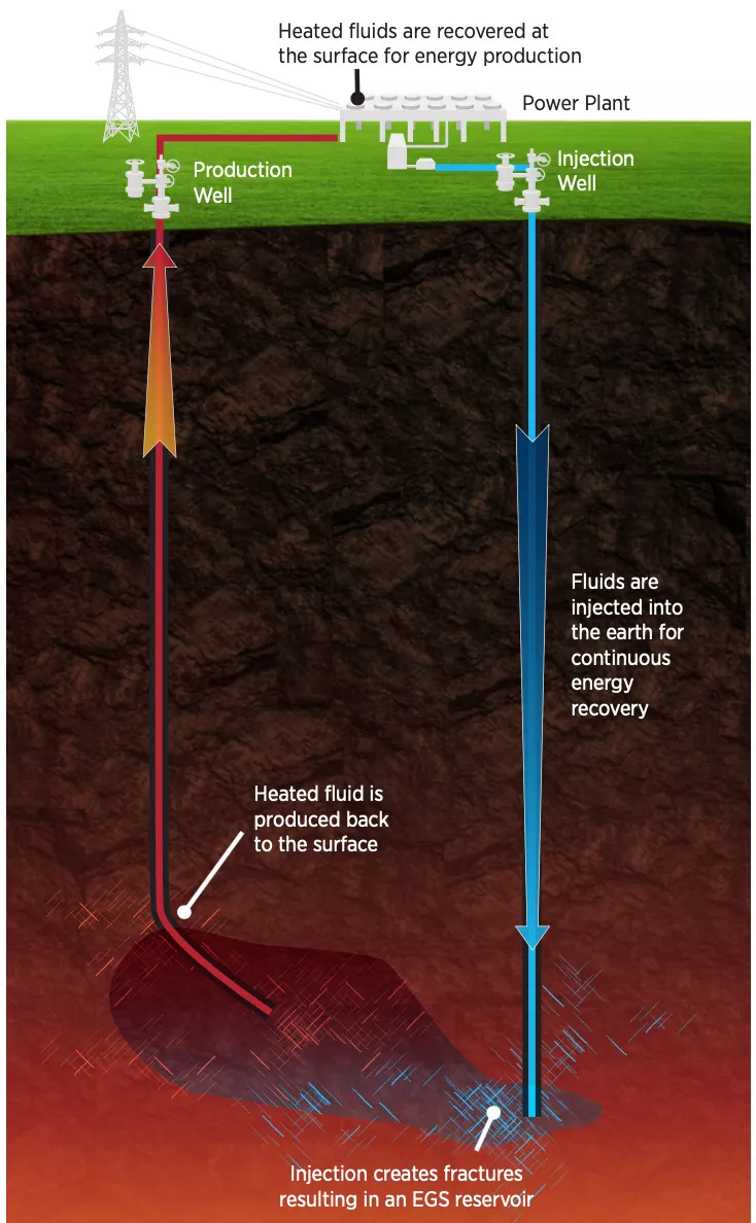
To be clear, the line between a conventional hydrothermal resource and a resource that requires EGS is not sharp. There are many gradations and variations between wet/porous and dry/solid.
“What you really have is a supply curve, where the variables are temperature, depth, well permeability, and reservoir permeability,” says Tim Latimer, founder and CEO of the EGS company Fervo Energy. “Everything between the two extremes exists.”
To put it simply, as the resource gets deeper and the rock becomes hotter and less porous, the engineering difficulty of accessing it rises.
The basic idea has always been that EGS would start off within existing hydrothermal reservoirs, where fields are relatively well-characterized. Then, as it learned, honed its technology, and brought down costs, it would branch out from “in field” into “near field” resources — solid rock adjacent to reservoirs, at similar depth. Eventually it would be able to venture farther out into new fields and deeper into hotter rock. In theory, EGS could eventually be located almost anywhere in the world.
That’s been the game plan for a decade now, and it’s still the game plan, as laid out in the magisterial 2019 GeoVision study on geothermal from the Department of Energy. The EGS industry has had trouble, though, getting all the ducks in a row. There was a burst of activity around 2010, based on Obama stimulus money and binary power plants. But by the time the drilling technology from the shale gas revolution had begun making its way over to geothermal, around 2015, capital had dried up and attention had turned away.
It’s only been in 2020, Latimer says, that everything has finally lined up: strong public and investor interest, real market demand (thanks to ambitious state renewable energy goals), and a flood of new technologies borrowed from the oil and gas industry. EGS startups like Fervo are growing quickly and bigger, established companies are running profitable EGS projects today.
Virginia is the first state in the U.S. South to target 100% clean power.
The engineering challenges remain daunting, especially as the targets get deeper and drier. There are PR challenges as well. Injecting fluids into the ground in order to fracture rock is known as “fracking” in the oil and gas business, and ... it’s got a bit of a reputation. In fact, there are whole US states and countries where it is banned.
The industry is keen to distance itself from gas fracking. The fluids used are benign, so there’s little danger of water pollution. Worries about induced seismic activity are somewhat overblown; in oil and gas drilling, it is high-volume water disposal wells associated with seismicity, and EGS doesn’t have those. The fractures are smaller, more controlled, and under far less pressure than in oil and gas fracking. As long as drillers avoid fault lines, which they’re getting better at doing, the risk is modest, especially relative to the benefits. (Ironically, geothermal projects have to meet more seismic safety conditions than comparatively far more dangerous oil and gas projects.)
And, of course, unlike with gas fracking, there’s no combustion of fossil fuels at the end of the line. EGS is benefiting from technology advances in fracking, but it is not doing the thing environmentalists hate. Explaining that to the public and policymakers remains a thorny challenge, though, to say the least.
Still, if the engineering and marketing challenges can be overcome, the prize is almost unthinkably large. Assuming an average well depth of 4.3 miles and a minimum rock temperature of 150°C, the GeoVision study estimates a total US geothermal resource of at least 5,157 gigawatts of electric capacity — around five times the nation’s current installed capacity.
Alternatively, using EGS for direct heat could provide the US with 15 million terawatt-hours-thermal (TWhth). “Compared to a total US annual energy consumption of 1,754 TWhth for residential and commercial space heating,” DOE writes, “this EGS-based resource is theoretically sufficient to heat every US home and commercial building for at least 8,500 years.”
There’s enough heat down there to sustain civilization for generations. And there’s even more heat deeper down, 6 miles and further.
3) Super-hot-rock geothermal
At the far horizon of EGS is “super hot rock” geothermal, which seeks to tap into extremely deep, extremely hot rock.
At extremely high heat, the performance of geothermal doesn’t just rise, it takes a leap. When water exceeds 373°C and 220 bars of pressure, it becomes “supercritical,” a new phase that is neither liquid nor gas. The science of supercritical water is funky (it’s like ... low-density water?) and I’m not going to attempt to explain it, but it is regularly used by industry, including in some advanced coal plants, so its properties are fairly well understood.
For our purposes, there are two important things about supercritical water. First, its enthalpy is much higher than water or steam, meaning it holds anywhere from 4 to 10 times more energy per unit mass. And second, it is so hot that it almost doubles the Carnot efficiency of its conversion to electricity.
“Not only do you get more energy out of your well,” says Eric Ingersoll, a clean energy analyst at the consultancy LucidCatalyst, “you get more electricity out of that energy.”
That means an individual geothermal project at 400°C would have about 50MW capacity, compared to the roughly 5MW capacity of an EGS project at 200°C — 42 percent hotter, 10 times the power.
You could get more power out of three wells on a 400°C project than you can out of 42 EGS wells at 200°C, using less fluid and a fraction of the physical footprint.
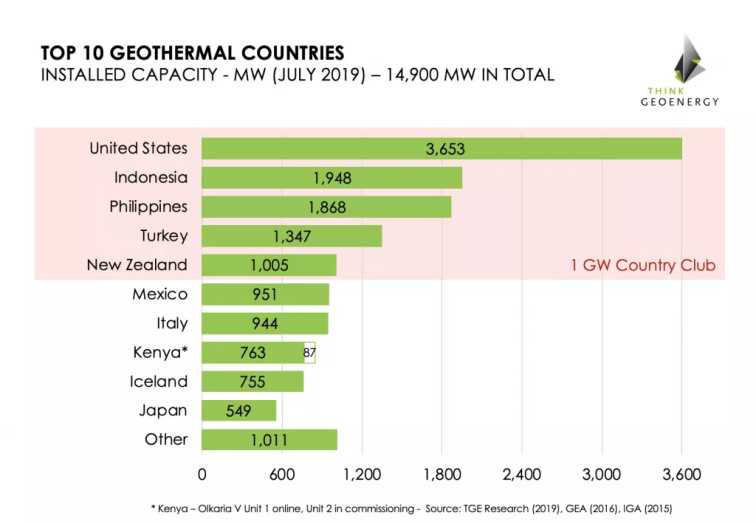
Experience to date shows that the hotter geothermal gets, the more competitive its power price, to the point that super-hot EGS could be the cheapest baseload energy available.
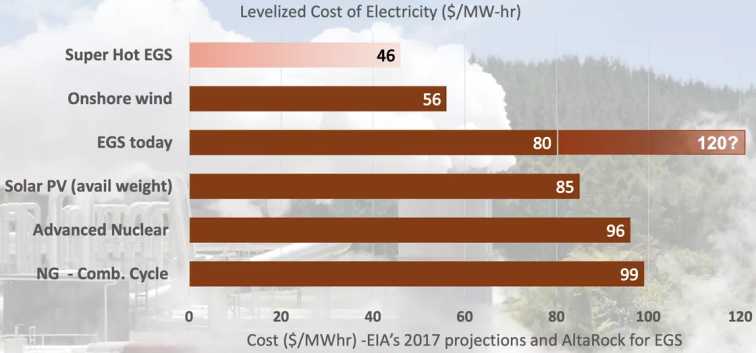
The engineering challenges are hairy. (Oil and gas engineers, the current masters of drilling, did not design for high heat; they didn’t need to.) New casings and cements need to be developed; water chemistry at high heat needs to be better understood; materials that resist corrosion and high heat need to be perfected; drilling techniques need to continue improving. There are even new, “non-contact drilling” methods being developed, including AltaRock’s, which uses frickin’ lasers (“millimeter waves,” technically).
No well is currently producing electricity from supercritical water, but several past wells (in Hawaii and California’s Salton Sea, e.g.) have encountered supercritical water and there are exploratory projects in Japan, Italy, Mexico, and several other counties to learn more.
It wouldn’t take much help to get this technology developing more quickly. “There’s an opportunity to spend a relatively small amount of money to galvanize the industry,” says Ingersoll. The US currently lacks a robust clean energy innovation system, but there’s a super-hot-rock research program at ARPA-E (AltaRock), a spinoff group called the Hotrock Energy Research Organization (HERO), and several demonstration projects pushing things along. More is needed. The reward — cheap baseload power, available almost anywhere — is too big to pass up.
A fourth category of technologies has emerged recently, which holds out similar promise that geothermal power could someday be accessible anywhere.
4) Advanced geothermal systems (AGS)
AGS refers to a new generation of “closed loop” systems, in which no fluids are introduced to or extracted from the Earth; there’s no fracking. Instead, fluids circulate underground in sealed pipes and boreholes, picking up heat by conduction and carrying it to the surface, where it can be used for a tunable mix of heat and electricity.
Closed-loop geothermal systems have been around for decades, but a few startups have recently amped them up with technologies from the oil and gas industry. One such company, started by investors with experience in oil and gas, is the Alberta-based Eavor.
In Eavor’s planned system, called an “Eavor-Loop,” two vertical wells around 1.5 miles apart will be connected by a horizontally arrayed series of lateral wells, in a kind of radiator design, to maximize surface area and soak up as much heat as possible. (Precise lateral drilling is borrowed from the shale revolution, and from the oil sands.)
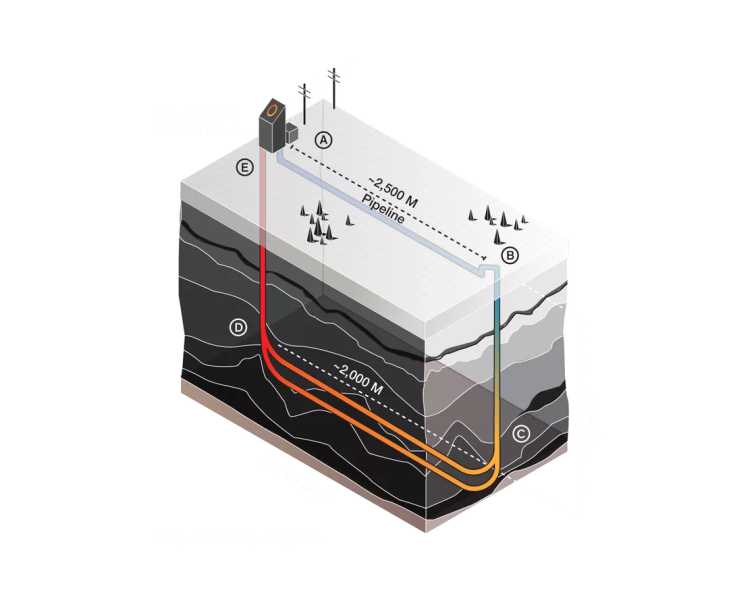
Because the loop is closed, cool water on one side sinks while hot water on the other side rises, creating a “thermosiphon” effect that circulates the water naturally, with no need for a pump. Without the parasitic load of a pump, Eavor can make profitable use of relatively low heat, around 150°C, available almost anywhere about a mile and a half down.
So far there’s an “Eavor-Lite” demonstration project built in Alberta, meant to prove out the basic concepts and technologies. It has shown that the lateral wells can be precisely targeted, the thermosiphon effect works, and the plant’s costs and output can be reliably predicted in advance. The company has three or four commercial plants in various stages of planning; likely up next is a plant scheduled to break ground in 2021 in Geretsried, Germany. (It will take advantage of Germany’s feed-in tariffs.) In France and the Netherlands Eavor will provide heat; in Japan, electricity; in Germany, a mix.
When I spoke with Eavor president John Redfern and head of business development Paul Cairns, they told me about a recent change in their design that will reduce the physical footprint and enable even more precise drilling. Instead of the two vertical wells being located at a distance, they will be right next to each other. Lateral wells branch out from them, staying parallel until they meet at the end. Like so:
With the wells so close to one another, they can use “magnetic ranging” (with a transmitter in one well and a receiver in another) to remain at a fixed distance from one another. Meeting at the end is easier than meeting in the middle.
As for land use, after the initial drilling, the only part that technically needs to be aboveground is the air cooler that cools the water before it descends. Power lines, even the electric generator itself, could be underground. And if there’s a water cooler rather than an air cooler, that too could be underground. “Theoretically,” Cairns says, “you could have zero surface footprint.”
Since all Eavor needs to work is hot rock, which is pretty reliably located beneath almost any site in the world, it avoids the need for expensive exploration and modeling. “We’re not smarter,” Redfern says, “we just have much simpler theoretical problems.”
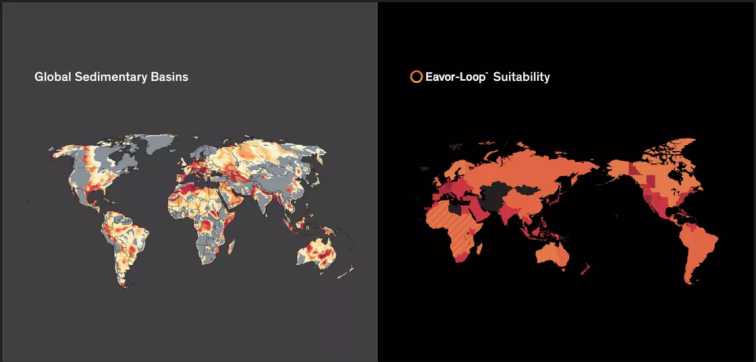
An Eavor-Loop can act as baseload (always-on) power, but it can also act as flexible, dispatchable power — it can ramp up and down almost instantaneously to complement variable wind and solar energy. It does this by restricting or cutting off the flow of fluid. As the fluid remains trapped underground longer, it absorbs more and more heat.
So, unlike with solar, ramping the plant down does not waste (curtail) the energy. The fluid simply charges up, like a battery, so that when it’s turned back on it produces at above nameplate capacity. This allows the plant to “shape” its output to match almost any demand curve.
Jamie Beard, who runs the Geothermal Entrepreneurship Organization at the University of Texas Austin, is bullish on AGS (she worries about the PR problems facing EGS), but she warns that Eavor — like other promising geothermal startups Fervo Energy, GreenFire Energy, and Sage Geosystems — does not yet have everything figured out, despite its confident claims. “I want them to have it in the bag,” she says, “but they don’t yet have it in the bag.”
Directional drilling in high temperatures, above 150°C or so, remains difficult, with equipment prone to melting (again, oil and gas engineers did not design their technologies with high heat in mind). As rock becomes harder, equipment must also be hardened to additional vibrations. And electronics need to be better insulated.
The Eavor-lite project is only mining heat of about 70°C. (It was not intended to be commercially viable.) To make geothermal work, Eavor and other companies will need to master going deeper and hotter. “You can’t economically produce geothermal energy at 90°C,” Beard says. “150, yeah, you’re getting there. 250, oh, yeah. 300, you’re solid.”
She stresses that there are no insuperable barriers if enough technical know-how and capital are brought to bear. The problem of extracting geothermal from deep, dry, hot rock, she says, “is largely an incremental engineering problem that, when solved, solves energy.”
“Solves energy” might sound like big talk, but in this case, it is not idle.
The extraordinary promise of geothermal.
The main problem facing renewable energy is that the biggest sources, wind and solar, are variable. Whereas fossil fuel power plants that run on coal and gas are “dispatchable” — they can be turned on and off on demand — wind and solar come and go with, well, the wind and sun.
Building an electricity system around wind and solar thus means filling in the gaps, finding sources, technologies, and practices that can jump in when wind and solar fall short (say, at night). And the electricity system needs to be extremely secure and robust, because decarbonizing means electrifying everything, moving transportation and heat over to electricity, which will substantially raise total electricity demand.
The big disputes in the clean energy world thus tend to be about how far wind, solar, and batteries can get on their own — 50 percent of total power demand? 80 percent? 100?) and what sources should be used to supplement them. (See this much-cited 2018 paper in the journal Joule on the need for “firm, low-carbon resources.”)
The answer currently favored by renewable energy advocates is more energy storage, but at least for now, storage remains far too expensive and limited to do the full job. The other top possibilities for “firming” electricity supply — nuclear power or fossil power with carbon capture and sequestration — have their own issues and passionate constituencies for and against.
Geothermal power, if it can be made to reliably and economically work in hotter, drier, and deeper rock, is a perfect complement to wind and solar. It is renewable and inexhaustible. It can run as baseload power around the clock, including at night, or “load follow” to complement renewables’ fluctuations. It is available almost everywhere in the world, a reliable source of domestic energy and jobs that, because it is largely underground, is resilient to most weather (and human) disasters. It can operate without pollution or greenhouse gases. The same source that makes the electricity can also be used to fuel district heating systems that decarbonize the building sector. It checks all the boxes.
“Our challenge is not that we have any enemies,” says Latimer. “If you want to talk to Democrats, we produce carbon-free electricity 24/7 — the last piece of the puzzle for a fully decarbonized electricity sector. If you talk to Republicans, it’s American ingenuity putting our drilling fleet to work on a resource that’s fuel-secure, doesn’t rely on imports, and puts the oil and gas people back to work. It’s a beautiful bipartisan story. The problem is we just don’t get talked about.”
Oil and gas to the rescue?
One thing that might get more people talking about geothermal is the somewhat serendipitous opportunity it offers to the oil and gas industry, which is reeling from oversupply, persistently low prices, and cratering demand caused by the pandemic. Consequently, it is haemorrhaging jobs.
Geothermal is buzzing with startups that specifically need innovation and expertise in drilling technology, the very skills many oil and gas workers already have. They could put those skills to work making the planet safer for future generations. That skills match is what animates Beard’s geothermal entrepreneurship organization and the $4.65 million contest that DOE launched this year to pair geothermal innovations with partners in the manufacturing industry.
There’s never been a better time to start or join a geothermal startup — most of them will fail, but there’s a future billionaire in there somewhere.
Industry veterans have taken notice. It made waves when, a few months ago, the “Frack King” — Mukul Sharma, an O&G engineer at UT Austin who has been key in the development of hydraulic fracturing — launched a new EGS venture called Geothermix.
“When we started in the unconventional [oil and gas] space, there were a lot of issues that needed to be resolved, but over time we have increased well productivity by a factor of 4 to 10 in many shale basins,” he told Heat Beat. “We are very early on the learning curve in the EGS context, but I have no doubt that we will be able to translate oil and gas learnings from the past decade and successfully deploy these methods in EGS.”
Latimer was an O&G engineer before he shifted to geothermal. Sage Geosystems was founded by Lev Ring and Lance Cook, two longtime O&G veterans. Eavor employs several O&G veterans.
The industry is taking notice as well. “We got a nice little head start, and we’re running like hell to stay ahead of it,” says Redfern, “but yeah, [oil and gas majors] are definitely turning their attention to this.”
What’s likely is that oil and gas majors will eventually start buying up geothermal startups. Investments in geothermal would give them a way to shelter part of their portfolio from the brutal oil market.
And geothermal is a more natural match than wind and solar for many of these companies. “The fact that it leverages industry core competencies for the purpose of producing clean energy,” Rao said, “will give it staying power in the industry, regardless of energy market conditions.”
Geothermal remains a relatively small industry, with a market cap in the single-digit billions, while oil and gas is a trillion-dollar industry. There’s no realistic way geothermal can promise to absorb all the jobs currently being lost in oil and gas.
Nonetheless, geothermal offers O&G something it badly needs: a port in a storm. It’s a growing clean energy industry that needs a smart workforce trained in exploration and drilling. Oil and gas has one of those.
Recent oil and gas technology innovations are going to turbocharge geothermal, especially if policymakers can get their act together and offer some support. There’s a steep learning curve ahead and they’re just now accelerating into it, but the next decade is likely to be more active for geothermal than the past four.
With an inexhaustible, dispatchable, flexible renewable energy source so close to breaking through, the vision of a fully renewably powered world seems less and less utopian, more and more tantalizingly within reach.